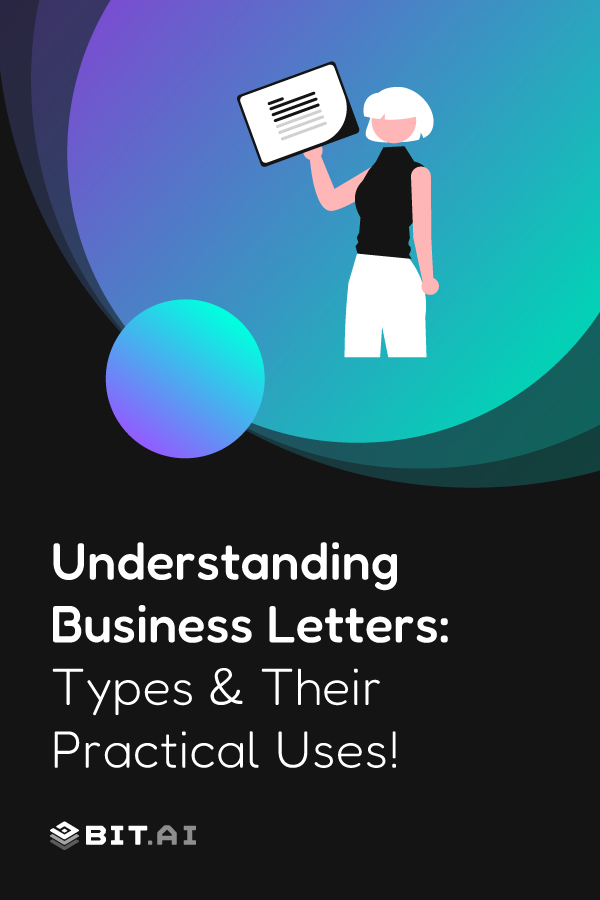Does your work require you to correspond and deliver information professionally to partners, clients, employees, colleagues, investors, consultants, etc.? In a world that is dominated by quick emails and chats, there is still a need to communicate with professional business letters. When we communicate via business letters, it’s a way for us to display respect, carry authority, and set a professional tone that informal messages and correspondence often lack.
Business letters are a cornerstone of professional communication.
That’s why knowing when and how to create the right types of business letters is essential for you to communicate effectively in a clear and confident manner, no matter what type of professional situation you are in.
Whether you’re formally accepting an offer letter, making a formal request, writing an apology letter, or resolving an issue, there’s a specific type of business letter that is tailored for each purpose. In this guide, we’ll walk through the key types of business letters and how they serve different communication needs.
Before we dive into the different types, let’s first understand what a business letter is and why it holds such importance in professional communication.
What is a Business Letter?
Okay, let’s break it down…
Simply put, a business letter is a formally written message for professional purposes. It is usually sent from one business to another or from a business to an individual, such as a client, employee, or job applicant. During your lifetime, you’ll have to write and have ‘AI’ write business letters for numerous reasons, including applying for a job, writing a complaint, providing feedback, requesting information, or confirming agreements.
What makes a business letter different from a casual note is its clear structure and polite tone. Unlike informal messages, business letters are straightforward, respectful, and get right to the point. The main goal behind sending a business letter is to make sure that the reader understands your message clearly and takes it seriously.
Now, that you know what a business letter is, let’s dive into the purpose of these letters!
Why Business Letters Still Matter

In today’s world, where instant messages and quick emails are very common, it might seem like business letters are a thing of the past. But don’t be fooled by these myths, business letters are still one of the most effective ways to communicate professionally. Whether you’re sealing a deal, making a formal request, or keeping a good relationship with a client, a well-crafted business letter shows clear, respectful, and serious communication. Plus, it creates an official record of your exchange, which can be very important.
So, even in this digital age, business letters carry weight, build trust, and set you apart. Let’s dig into why business letters remain essential today!
1. Present Key Information Formally and Clearly
Business letters add a formal and professional touch to important messages. Whether someone is sharing an update, confirming a deal, or announcing a new partnership, the formal tone and clear structure of a business letter help ensure that your message is taken seriously and understood without confusion.
2. Establish a Professional Relationship
The business letters are not just for formality—it’s your chance to make a real connection with your clients. Maybe you’re introducing yourself to a new client, reaching out to a potential partner, or simply keeping in touch with someone you already work with. A short note—whether it’s a thank-you, an invite, or a quick follow-up—can show professionalism, build trust, and strengthen your relationship.
And over time, these small touches can open doors to stronger, long-term partnerships.
3. Record Agreements, Commitments, and Decisions
Business letters are very important formal letters because they provide a written record of key agreements, terms, and decisions. Whether you’re confirming a deal, accepting an offer, or outlining responsibilities, these letters serve as a trusted source both parties can refer to later.
4. You Can Give Feedback, Complaints, or Acknowledgements
Writing a business letter is a professional way to share thoughts, whether it is positive feedback, a complaint, or a simple acknowledgment. That’s why you can use these business letters to highlight excellent service, raise concerns, or address issues in a respectful manner. This not only keeps the communication professional but also helps focus on solutions rather than just the problem.
Learn more 👉 Complaint Letter: What is it & How to Create it?
5. You Can Introduce Your Services and Collaboration Ideas
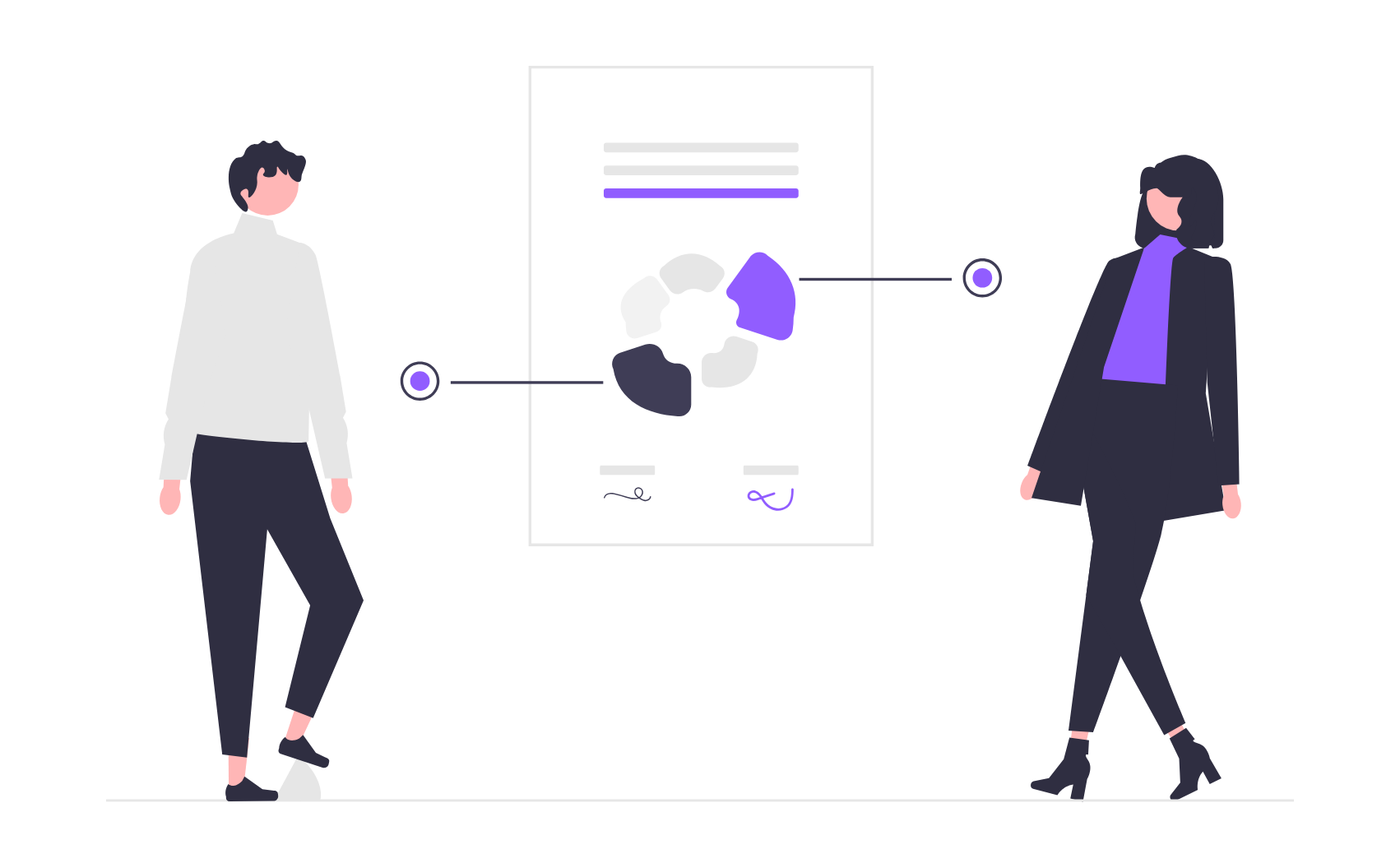
A business letter can be a great way to open the door to new opportunities. Whether you’re suggesting a partnership, asking for information, or presenting your services, a well-written business letter helps you explain your ideas clearly and professionally. The business letters give you the space to highlight the benefits you offer and invite further conversation—laying the groundwork for meaningful cooperation.
Now that you know why business letters are so important, let’s explore the different types and when to use each one.
15 Key Types of Business Letters and Their Uses
Business letters come in many forms, each designed for a specific purpose in the workplace. Whether it’s a letter asking for information, a job application, a complaint, or a resignation, each type plays an important role in clear and professional communication. Knowing the different types and when to use them helps you send the right message with the right tone.
Let’s explore the main business letter types and how they can support your work.
✉️ #1. Cover Letter
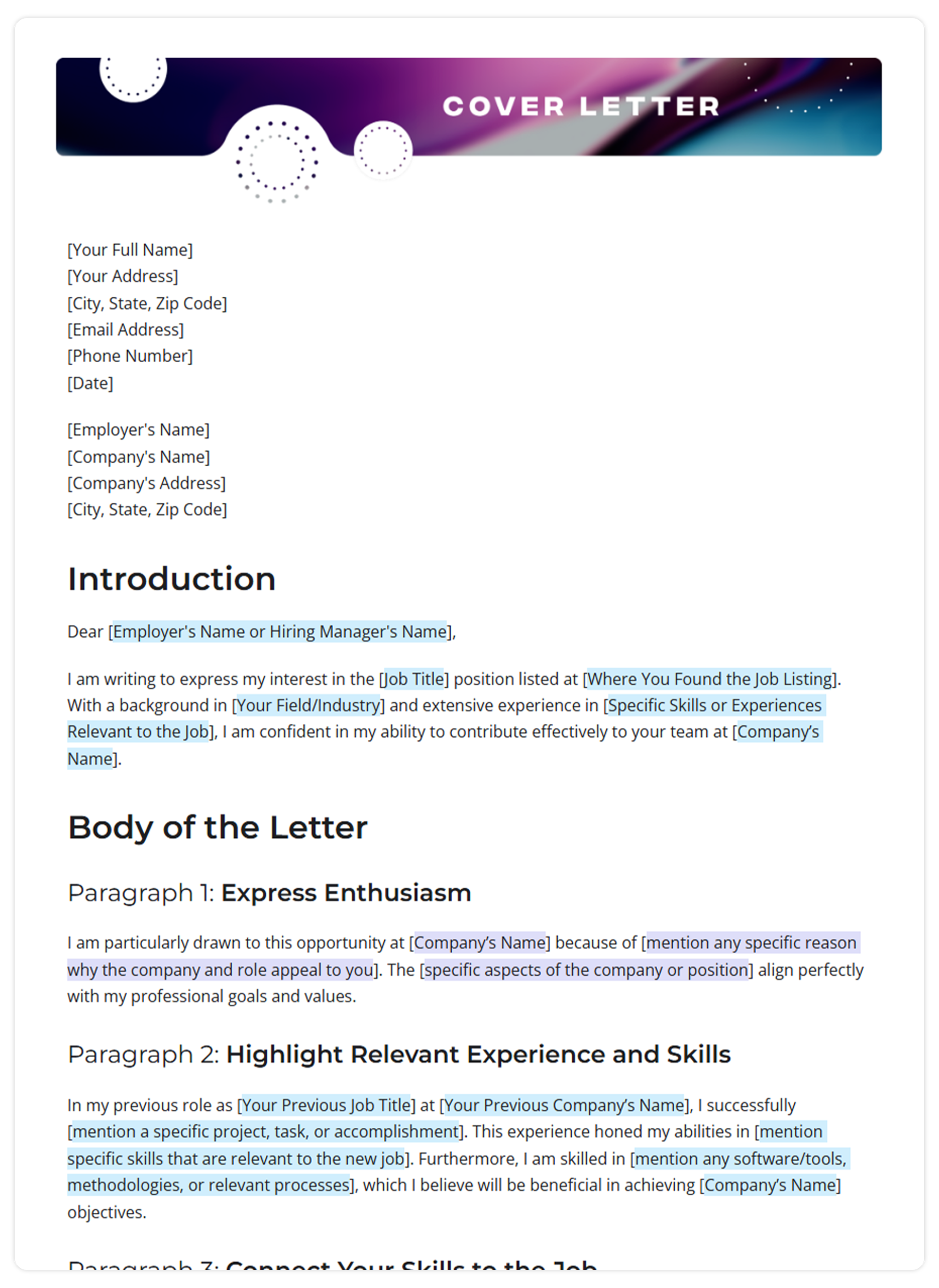

Let’s start our list with the first and most important one… Cover Letter! Think of the cover letter as your chance to introduce yourself, share your story, and show why you are the right fit for the job. A cover letter is your opportunity to express your talent, background knowledge, and desire to work, much more than the things you placed in your resume.
A well-crafted cover letter reflects your personality in the application and helps you stand out. It also shows that you’ve taken the time to understand the company and role.
Use Case: You can send this letter together with the job application to show your competence to work in the company. A well-written cover letter can help your application stand out in a crowded field.
❓#2. Inquiry Letter
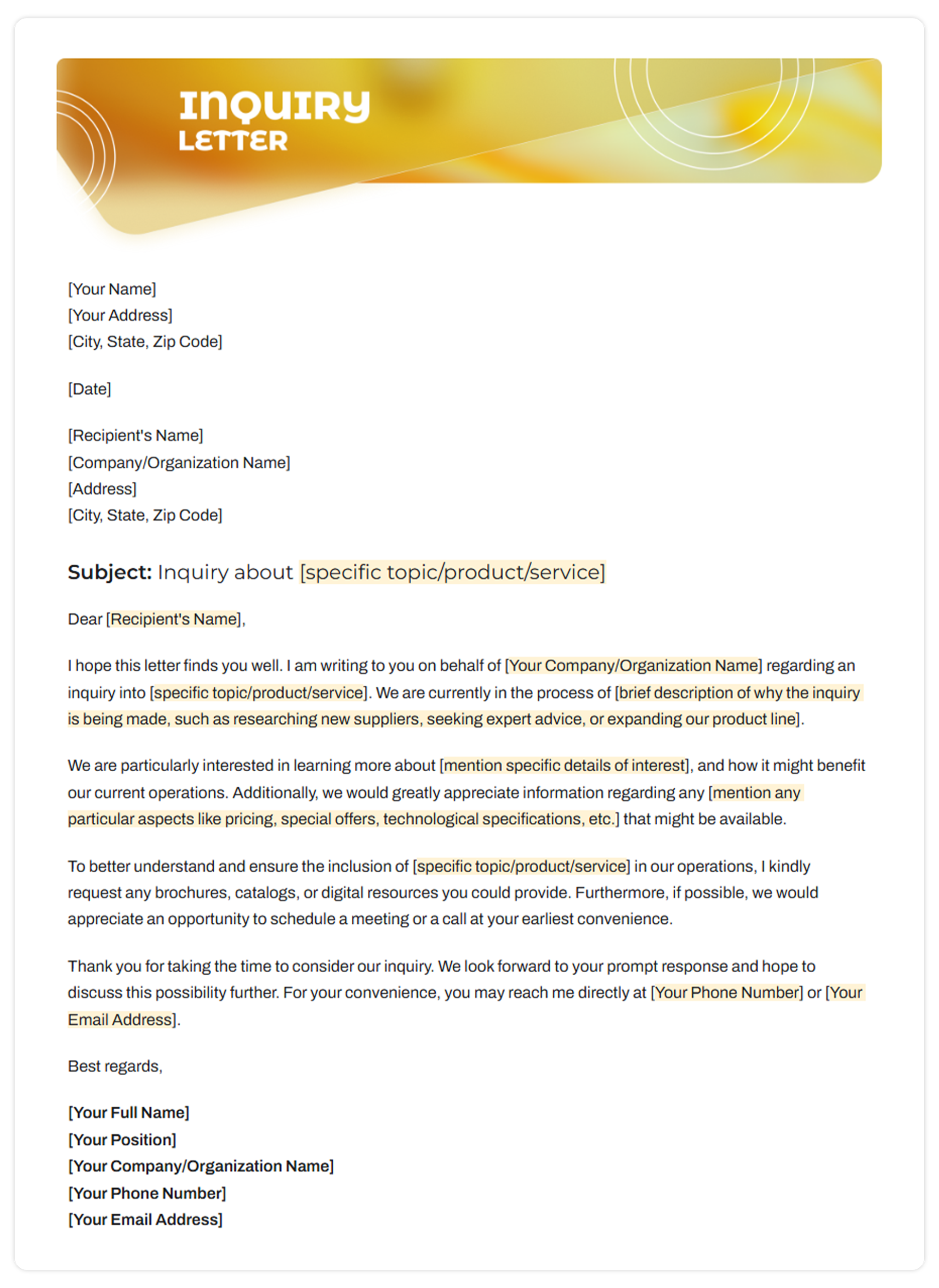

An inquiry letter is used when you require information about a good or service, or an opportunity. Inquiry letters can lead to better decisions because they clarify important information before you proceed. A well-written inquiry saves you time and can eliminate potential misunderstandings, which offers a smoother process in future communication.
Use Case: Inquiry letters can be used when you are considering a possible purchase, partnership, or seeking information regarding a job or business opportunity.
📦 #3. Order Letter
Order letters are formal requests for products or services. They act as official records of what is being bought, helping both sides (buyer and seller) stay clear about the order. By using order letters, businesses can avoid mistakes and keep transactions running smoothly.
Use Case: Businesses write order letters to say what they want to buy, how much, and how it should be delivered. This way, there are no misunderstandings about the order details.
😲 #4. Complaint Letter
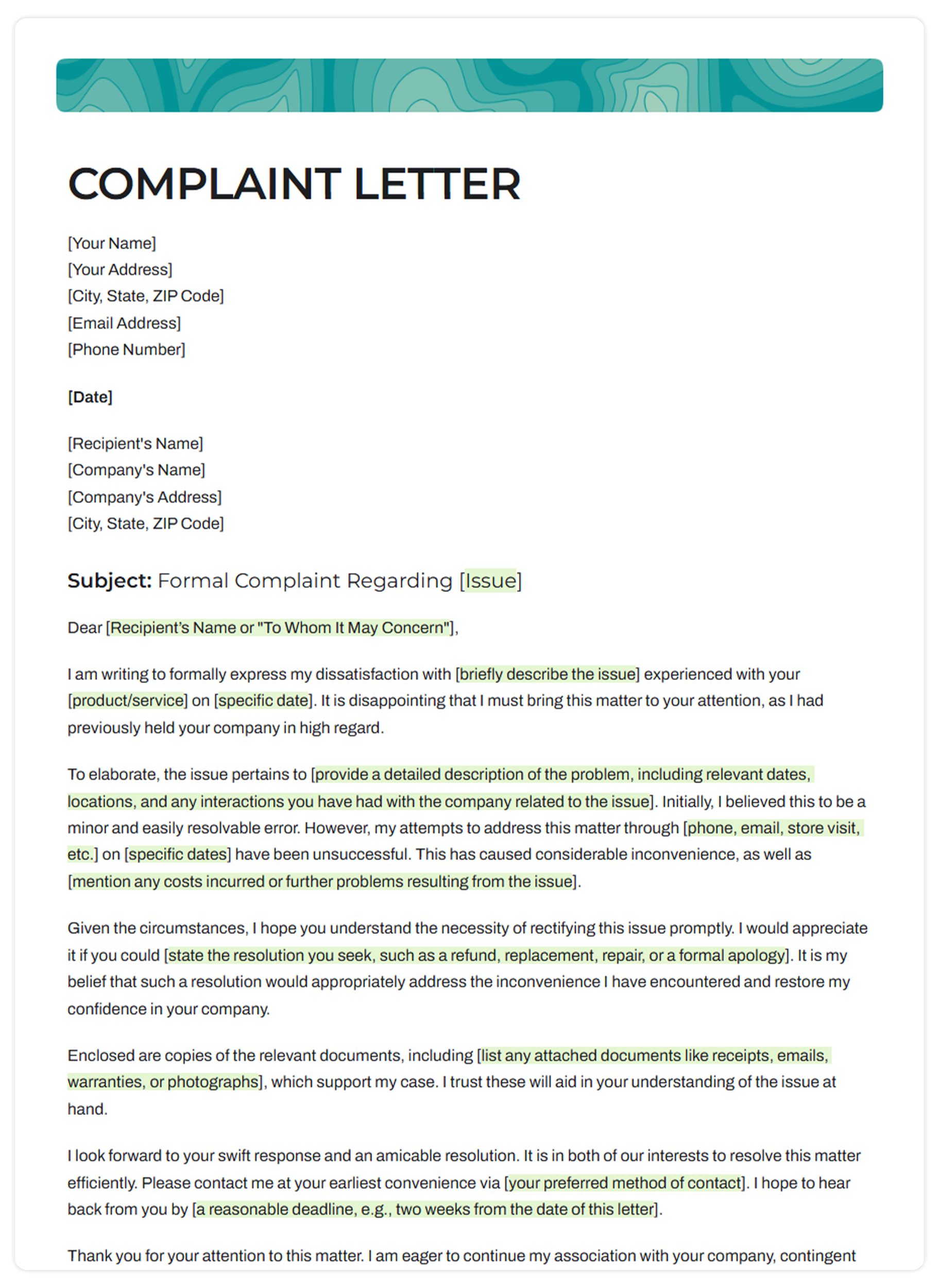

A Complaint letter is one of the ways to show your dissatisfaction with a product or service. It helps the company recognize and fix problems it may not be aware of. A constructive complaint can improve future service and protect your rights.
Use Case: This letter can be used if you have received a defective product, poor service, or something that didn’t meet your expectations. Keep the tone neutral and professional to increase the chances of a positive response.
💰#5. Sales Letter
A sales letter is a written message that tries to get people interested in buying a product or service. It explains why the product is good and encourages the reader to take action, like making a purchase or asking for more details. Good sales letters speak directly to the reader and focus on how the product can help them without being too forceful.
Use Case: Sales letters are often sent in marketing to tell people about new products, show benefits, and motivate them to buy or book a service.
🧑🏫 #6. Reference (Recommendation) Letter
A recommendation letter is used to support someone’s skills, character, or work ethic. The reference letter shows that a trusted person believes in the applicant, which helps in building confidence with employers or schools regarding that applicant. These letters often make a big difference in hiring or admissions decisions. The recommendation letters provide a personal view that resumes can’t, highlighting strengths the candidate might not mention themselves.
Use Case: Recommendation letters are letters of support written by the supervisor, colleagues, or professor and aid the job, academic, or professional application, which makes the receiver stand out.
🤝 #7. Acceptance Letter
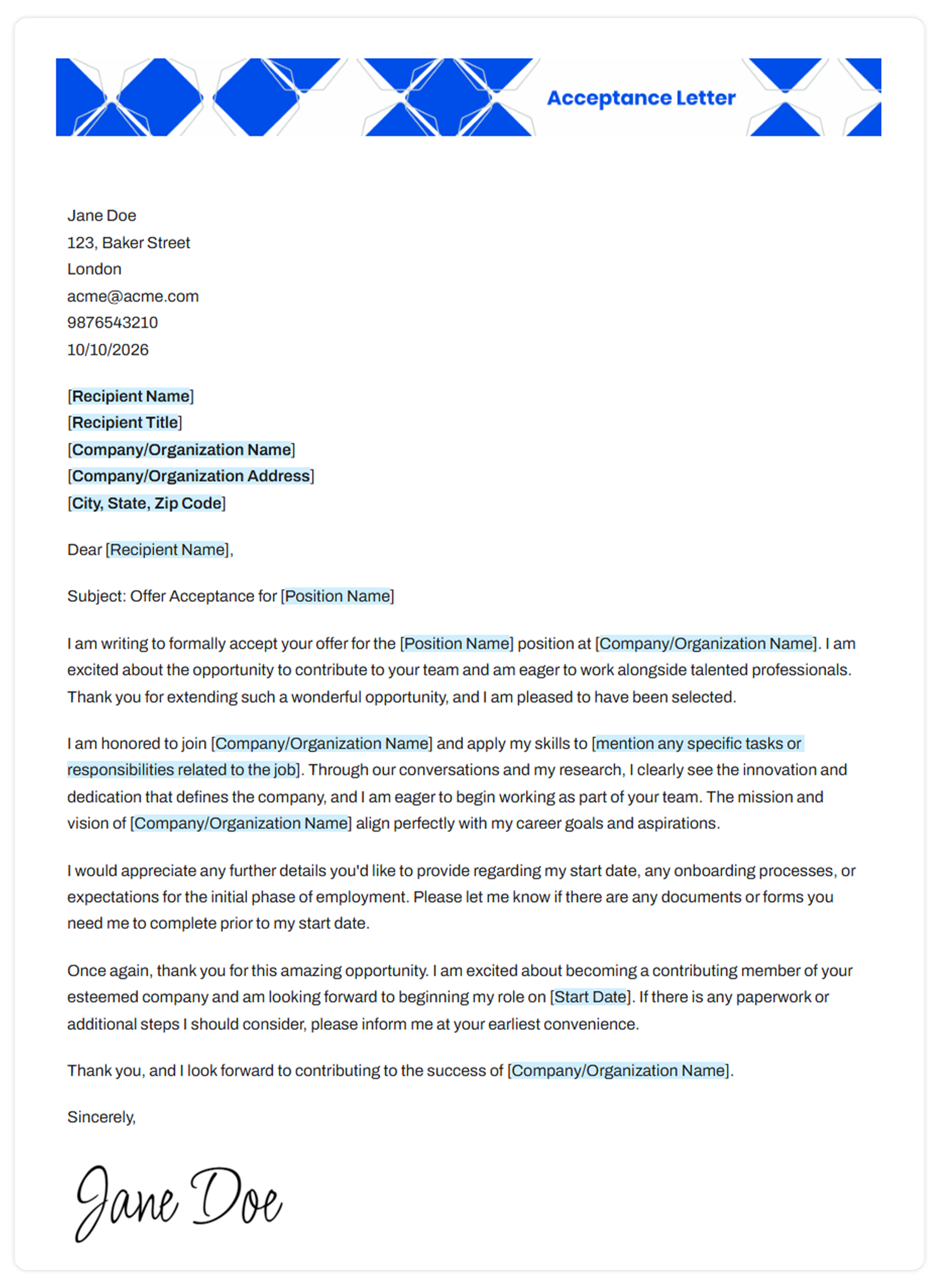

An acceptance letter is a message that confirms to the company that you agree to the terms of an offer, invitation, or proposal. It helps both parties move forward with a clear understanding and shows professionalism.
Use Case: This kind of letter is used to formally accept an invitation to an event, a contract, or a job.
🙋♂️ #8. Resignation Letter
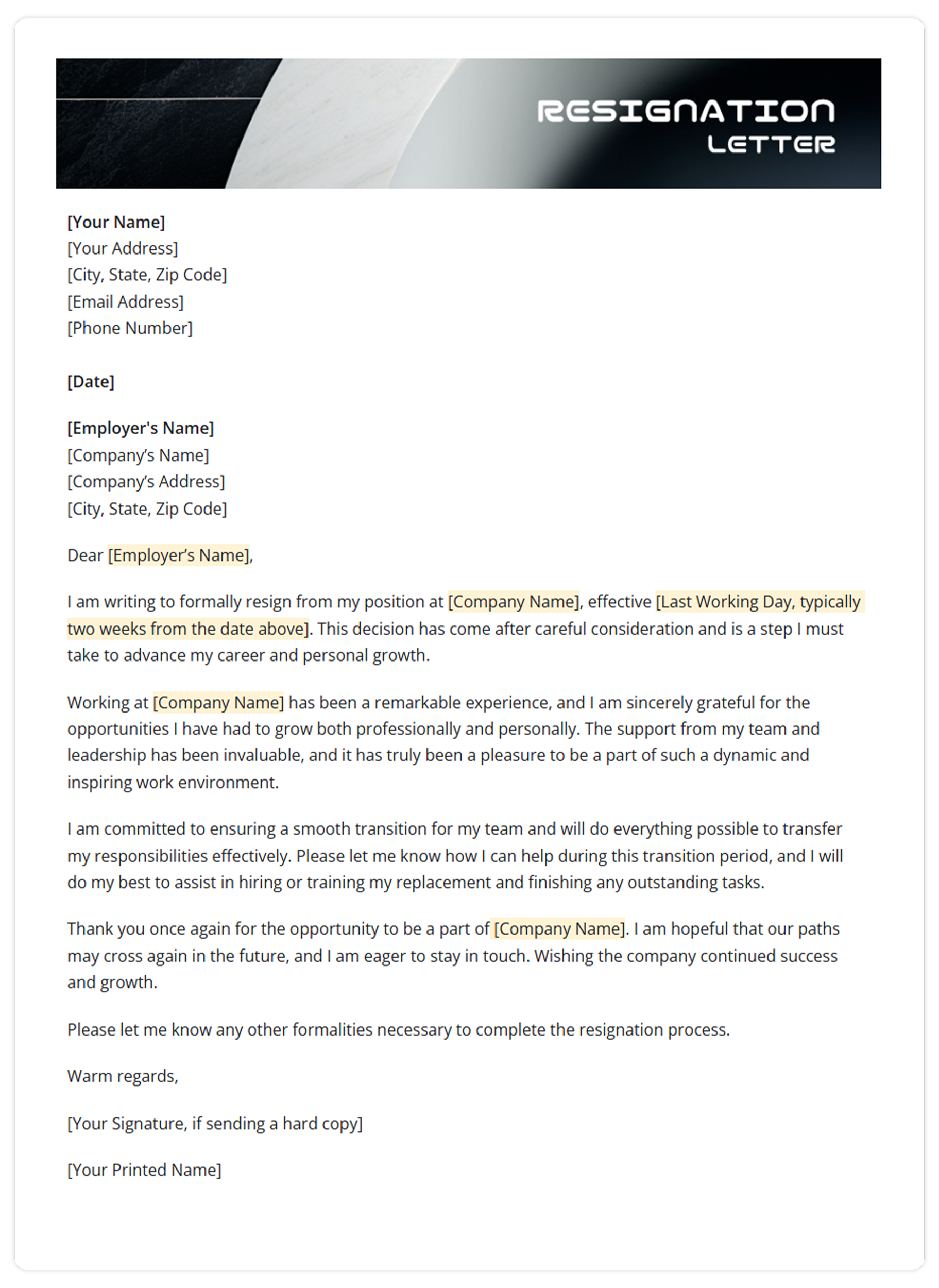

A resignation letter is a formal note to let your employer know that you plan to leave your job or position. Writing a clear resignation letter helps create a smooth and respectful exit. It keeps relationships positive and gives your employer time to find a replacement. A good resignation letter shows professionalism and keeps the door open for future opportunities or recommendations.
Use Case: Send this letter to your employer as a polite and professional way to leave the company with a smooth transition.
🔧 #9. Adjustment Letter
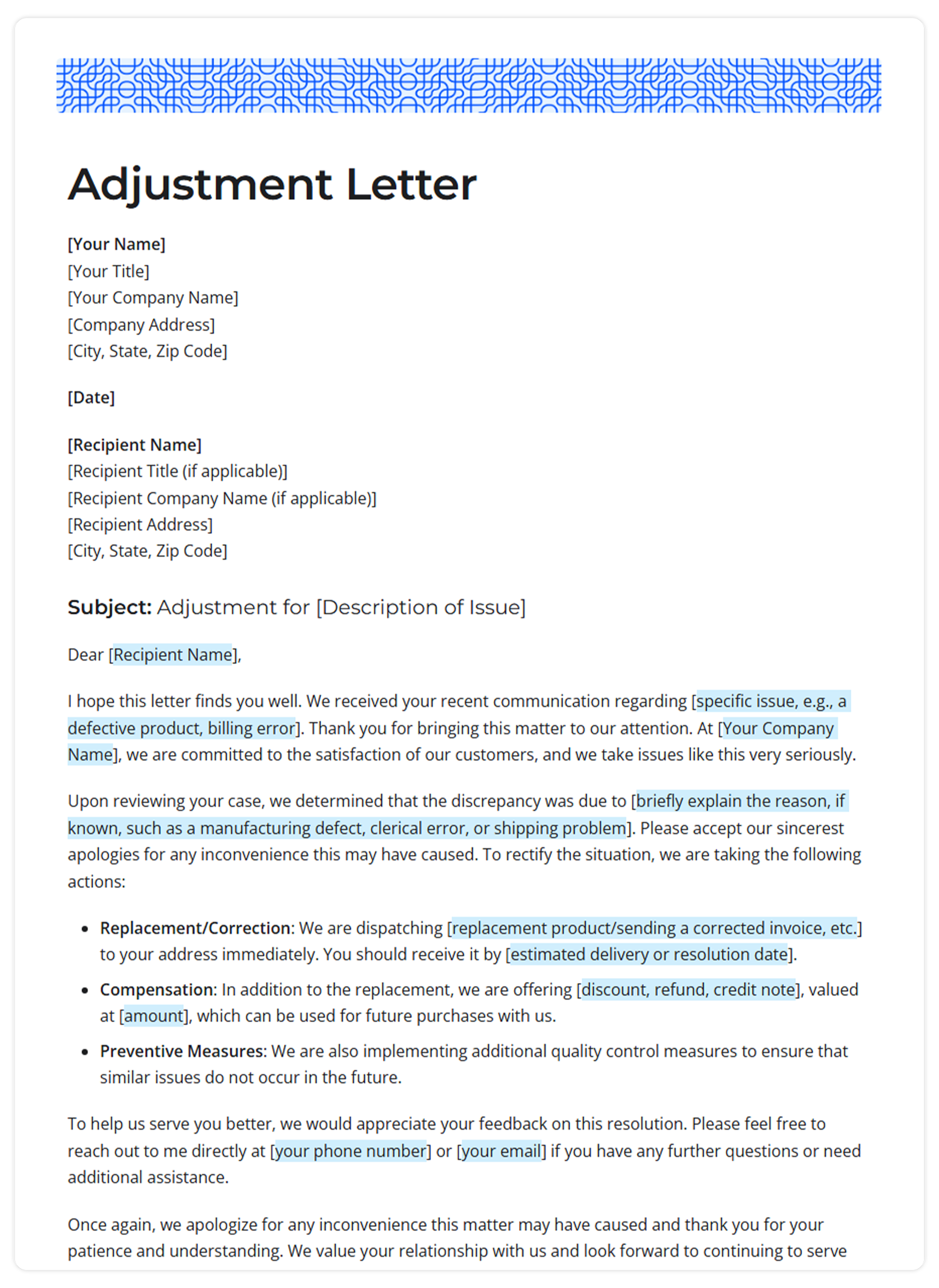

An adjustment letter is written in response to a complaint or claim. It explains how the problem will be fixed, showing that the company cares about customer satisfaction. These letters help rebuild trust and keep customers loyal.
Use Case: Businesses send adjustment letters to reassure customers, protect their reputation, and solve issues quickly when problems arise.
🙏 #10. Apology Letter
An apology letter is a message that expresses regret for a mistake, misunderstanding, or problem. It shows that you take responsibility and want to make things right. Writing an apology helps clear up any confusion and prevents more problems later.
If needed, a well-written apology letter can rebuild trust and preserve good relationships with clients, partners, or colleagues.
Use Case: Use this letter to apologize, explain why something went wrong, and rebuild trust with clients, partners, or colleagues.
🎉 #11. Invitation Letter
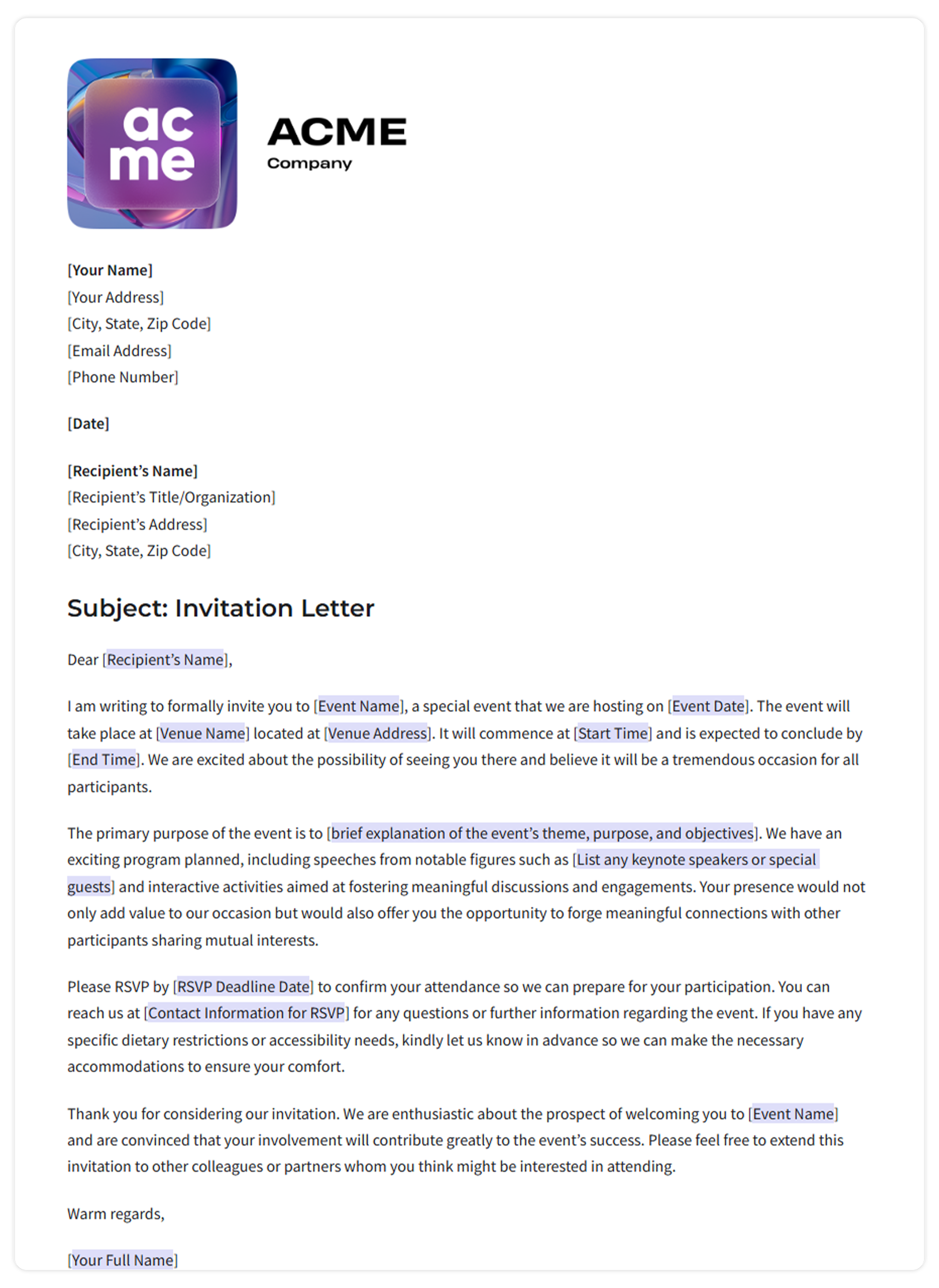

Invitation letters are written to formally invite someone to attend an event, meeting, or function. The invitation letters basically include essential details such as the date, time, location, and purpose of the event. Usually, a well-crafted invitation letter sets a welcoming tone and encourages people to participate in the event.
Use Case: These letters are commonly used to invite guests to business conferences, product launches, and important meetings, ensuring recipients have all the necessary information well in advance.
🔁 #12. Follow-up Letter
Here comes the Follow-up letter. A follow-up letter is sent after a previous meeting or conversation to keep things moving. It can be used to thank someone, remind them about what needs to happen next, or ask for an update. Whether after a job interview, meeting, or proposal, a follow-up letter shows your interest and keeps the conversation active.
Use Case: You can use a follow-up letter to politely thank someone for their time, or check on progress after an interview, business meeting, or proposal.
✂️ #13. Termination Letter
Okay, the letters of termination are used when ending a business relationship, contract, or employment. They make sure the decision is communicated clearly and officially documented. A well-written termination letter helps avoid confusion, reduces the risk of legal disputes, and protects the interests of both parties involved.
Use Case: These should be transmitted when firing a worker or terminating a service contract, and make the process simple and documented.
🗒️ #14. Circular Letter
A circular letter is used to share the same information with many people at once. It’s often used to announce important news, policy changes, or updates to a large group like employees or customers.
Circulars ensure that everyone receives the same message at the same time, which keeps the communication clear and consistent.
Use Case: A circular letter is ideal for sharing important news, like new rules, upcoming meetings, or product launches, with a large group of people.
🙌 #15. Thank You Letter
Now, the last one, A thank you letter, which is a simple way to express your gratitude and appreciation. It helps show respect and acknowledge someone’s effort, time, or kindness. Writing a thank you letter strengthens relationships and leaves a positive impression, whether in business or personal life.
Use Case: Send a thank you letter after interviews, meetings, or any act of support to express your appreciation and build goodwill for ongoing relationships.
Now that you’re familiar with the different types of business letters, let’s break down how to format one correctly to ensure your message is clear, professional, and impactful.
How to Format a Business Letter the Right Way
A business letter is not merely about putting your words on paper, but also about how you will be presenting your message to the readers in such a way that comes out professionally. Now, we are going to have a closer look at the contents and formatting hints that can help us to create a successful business letter.
Components of the Perfect Business Letter!
- Your Address: Write your full address at the top of the letter. If you’re using official company stationery (called letterhead), this part is often printed already, so you don’t need to add it again.
- Date: Add the date below your address. Write it clearly, like “August 29, 2025,” so it’s easy to read.
- Recipient’s Address: Include the full name, job title, company name, and address of the person you’re sending the letter to. This helps make sure it gets to the right person.
- Greeting (Salutation): Start with “Dear Mr./Ms. [Last Name].” If you don’t know the name, use “Dear Sir or Madam.”
- Body of the Letter: This is the main part where you write your message. Usually:
- Begin by stating the reason for writing.
- Add details or explanations in the middle.
- Finish by summarizing or stating what you hope will happen next.
- Closing: End the letter politely with phrases like “Sincerely,” “Best regards,” or “Yours truly,” followed by a comma.
- Signature: Leave space for your handwritten signature if printing. Then type your name below it. Include your job title if needed.
- Attachments (if any): If you’re including extra papers, mention them at the bottom. Write “Enclosure” or “Attachments,” then list what you are sending.
Ready to take your business letter writing to the next level? Discover how Bit.ai can help you create polished, professional letters with ease and confidence.
🚀 Struggling to draft the right business letter? Now create professional letters and collaborate with your team in real time with Bit.ai!
Write Business Letters Confidently With Bit.ai!
Writing business letters can be tough. You want to sound professional, get your message across clearly, and avoid mistakes—all while saving time. That’s where Bit.ai makes a big difference. With Bit.ai, you get:
✅ Easy-to-use templates that guide your writing
✅ Tools to keep your letters clear and polished
✅ A fast way to collaborate and share your work
Now, writing business letters feels simple and confident, no matter your experience level. Let’s explore the amazing features of Bit.ai.
• Formal Letter Template: Bit.ai offers ready-to-use templates for formal letters. These layouts include the perfect structure: a clear one-line summary, opening, body, closing, and signature sections.
• AI Genius Writer: Struggling to find the right words? Bit.ai’s integrated AI prompts (including a dedicated “Formal Letter” prompt) help generate polished, well-structured letters with appropriate tone and formatting.
• Interactive Smart Documents: Embed rich media like PDFs, charts, links, or spreadsheets directly into your letter, transforming static documents into interactive, information-rich experiences.
• Real-Time Collaboration: Co-write with your team, leave inline comments, mention collaborators, and track version history to ensure clarity and eliminate miscommunication.
• Secure & Trackable Sharing: Share your letter via password-protected links, set link expiration dates, and monitor document engagement for added security and insight.
• Smart Wikis: Bit.ai lets you create smart documents and wikis where your team can write, edit, comment, and organize everything in one place. You can manage projects, knowledge bases, client docs, and internal notes all in one clean workspace.
• 100+ Integration: It connects with 100+ apps like Google Drive, YouTube, and Airtable so you can add videos, charts, and files right inside your docs. This helps keep all your content connected and easy to find, which means no switching between tabs or apps.
With Bit.ai, writing business letters is no longer a tedious task. Instead, it becomes an easy and creative process. From well-designed templates to helpful writing tools and secure sharing options, Bit.ai gives you everything you need to write clear, polished, and professional letters every time.
💡Pro Tip: Always proofread your letter before sending it. Spelling mistakes or unclear sentences can ruin your message and credibility. For extra polish, use tools like Bit.ai’s AI Genius Writer to refine tone, clarity, and structure in seconds.
Wrapping Up
Whether you are applying for a job, responding to a formal request, or communicating important information in a business context, knowing how to write an official letter is a useful skill and a great first impression. An official letter conveys a lot; it shows professionalism, clarity, and respect for the time of your reader.
Also, there are smart tools, like Bit.ai, that will make every step of writing business letters smoother, more intelligent, and easier to collaborate. So, are you ready to compose one that others will notice? Begin with purpose, write clearly, and conclude with confidence.
Stay sharp and professional! 🌟
FAQs
Q1. What are the purposes of business letters?
Business Letters are used for informing, requesting, confirming, offering, complaining, recommending, and other official and professional purposes.
Q2: What are the three types of letters?
The three types of Letters are:
• Formal letters are used for business/professional purposes.
• Casual letters are used for personal use, and
• Semi-formal letters are used for such things as job applications and recommendations.
Q3: What is the relevance of a business letter?
It clearly and professionally expresses your objectives, decisions, or comments and is usually used as a written record of your communications.
Q4: What are the different styles of business writing?
Business communications include letters, emails, reports, proposals, notes, and meeting minutes.
Keep Reading & Learning 📚
